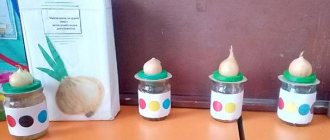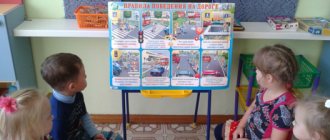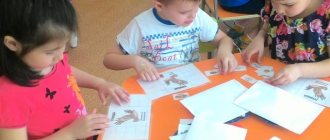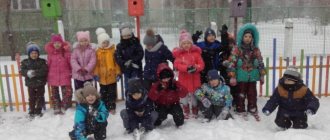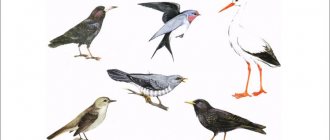MAGAZINE Preschooler.RF
Project “What do we know about onions”Currently, project activity is one of the effective forms of educational work with children in preschool educational institutions. Our project is educational and research, where children learn a lot of new things, explore, experiment, and conduct various experiments. This project: firstly, allows you to feel like a researcher. Secondly, the project method allows you to unite children, parents and educators in joint activities. The most important result of project-based learning is the formation of a real community of children, educators and parents. Our project is called “What do we know about onions”: The goal of the project: to form the environmental education of preschoolers, to activate the mental and search activity of children. This goal can only be achieved through joint efforts based on the following principles: systematicity and consistency, the principle of taking into account age and individual characteristics, and the principle of clarity.
Project participants: children, group teachers and parents. This is a long-term project; we have completed work on the project “What do we know about onions”. And now we will tell you about it. Subproject “What do we know about onions”. Type of project: educational – environmental. Issue: What kids need to know about the green vitamin. Materials: soil, water, onions, containers for planting, observation diary, watering can, sticks for loosening the soil, scissors, children's encyclopedia for children. Preliminary work: Introduction to the work of art by G. Rodari “Cipollino”, reading poems about onions, memorizing proverbs and sayings, solving riddles; examination of illustrations, paintings depicting vegetables (compare them by color, shape, size, taste). Conversations about how to grow vegetables in the garden and at home. Writing fairy tales together with parents. Carrying out an environmental campaign “Onions for seven ailments” Goal: Expanding children’s knowledge of how to create a garden bed on a windowsill and care for bulbs; activate the child’s initiative, attention and memory, enrich the child’s vocabulary, involve children, teachers, and parents in the work of the project. Objectives: 1. Teach children how to care for onions daily in winter indoors. 2. To form children’s understanding of the need for light, heat, and soil moisture for the growth of bulbs. 3. Record children’s ideas about changes in the growth of bulbs in a container with soil. 4. Teach to take care of nature. 5. Teach how to carry out individual and collective assignments, 6. Teach children to see the result of their work. STAGE 1 – preparatory. What greenery is there by the window? After all, it’s winter outside our window. They say that onions are good for seven ailments. The kids were planting onions. We were treated to the harvest, a treasure trove of vitamins. Come all to our garden. The project arose on the initiative of the children of the group themselves. During the conversation with the children, it turned out that everyone knows: onions are healthy, you need to eat them in order not to get sick. But almost no one knew what was useful in it and how it should be grown. In the group room of the kindergarten we created beds on the windowsill. But before starting the experiment, preliminary work was carried out: together with the children, we prepared an observation diary and selected fiction: sayings, poems, fairy tales, riddles about onions. An event was held with children “Onion for seven ailments” We introduced the children to a section from the children's encyclopedia about onions. We learned that there are many types of onions (baton onions, chives, onions, leeks). We also learned that onions became widespread in Russia back in the 8th century; even in a poor family they could not cook soup without an onion. She was not only a seasoning, but also a protector against all diseases. It was a healthy and wholesome food. Children now know that onions are medicine. Onions have special volatile substances - phytoncides, which kill many types of pathogenic microbes. A piece of onion is enough to kill all the germs in your mouth. During the project, work was carried out with parents: - Searching for information about onions - Writing fairy tales - Drawing competition
Properties of onions Onions have bactericidal and antiseptic properties, fight viruses and accumulate the life-giving energy of the earth. Onions improve appetite, food absorption, and increase the body's resistance to infectious diseases. Fresh onion juice mixed with honey is a good remedy for treating eyesores, bronchitis, coughs and fungal skin diseases. Onion juice is also recommended for neurasthenia, insomnia and rheumatism. Fresh onion pulp is used for the flu, against mosquito bites, hair loss, and to remove calluses and warts. Baked onions are applied to boils, and freshly chopped onions are applied to the temples for headaches. Leeks are recommended for use in cases of obesity, salt deposits and kidney stones. STAGE 2 – research. At the beginning of February we brought onions and cut off the tops. Onions were grown in a container. Children watched the growth of onions and conducted experiments. They established connections: plants - earth, plants - water, plants - people. The results of the experiments were recorded in an observation diary. In the process of research, children became acquainted with fiction about vegetables: sayings, poems, fairy tales, riddles. We looked at illustrations and paintings on vegetable themes. Classes, didactic games, and conversations were held. Green and healthy Doctors believe that green onions should be eaten every day. Firstly, it causes the release of large amounts of gastric juice and hydrochloric acid, which promotes the digestion process and better absorption of food. Secondly, 100 g of green onions contain about 50 mg of vitamin C. This amount is enough to satisfy the daily requirement of an adult. It is worth especially noting that green onions, unlike onions, contain chlorophyll, which is necessary for hematopoiesis. Therefore, it is especially necessary for people suffering from various types of anemia. It should be remembered that the most valuable thing in green onions is the white fleshy stem; feathers up to 10 cm from the white part are useful. The rest of the green onions may cause some undesirable effects, such as fermentation in the stomach, headache, irritability or drowsiness. STAGE 3 - final. • Analyzed and summarized the results obtained in the process of children's research activities. And at the end of our experiment, together with the children, we identified the conditions for onion growth: Onions, like any plant, need: - light - heat - air - water - Man Onions are a long-day plant. It tolerates cold well and can grow at positive temperatures, close to zero degrees. Onion seeds germinate slowly in soil under normal conditions. You need to soak them first. • We created an exhibition of drawings. The grown onions were served for dinner. Result. 1. Children learned to plant and care for onions, became acquainted with the conditions for onion growth, and learned to notice the benefits and beauty of green onions in winter. 2. The children developed knowledge and ideas about the growth of green onions in indoor conditions, both in a container with soil and in a glass of water. The process and result of the project brought satisfaction to the children, the joy of experiencing success, awareness of their own skills and competence. The children are ready and willing to complete the next project collectively.
| Next > |
Chemical composition of onions
The positive effect of the product on the body is the result of the action of its components - vitamins, micro- and macroelements.
Nutritional value per 100 g of product:
- calorie content - 41 kcal;
- proteins - 1.4 g;
- fats - 0.2 g;
- carbohydrates - 8.2 g;
- fiber - 20 g.
| Vitamins: | Micro- and macroelements: |
|
|
In addition, onions contain small amounts of vitamins A, B2, B9, B7, K, as well as the trace element selenium, unsaturated fatty acids Omega-3 and Omega-6 . Although the calorie content of the vegetable is low and is less than 3% of the daily value, it contains 15% of the dietary fiber, 11% of vitamin C, satisfies the body's need for silicon by almost 17%, cobalt by 50%, and magnesium by 11%.
Did you know? In terms of sugar content, onions are ahead of apples and pears.
That is why, when fried, it caramelizes and acquires a sweet taste and smell.
"People" and "people"
Delving deeper into the topic of “Luka: Characteristics” (“At the Bottom”), it can be noted that it is this hero who becomes the only person who truly sympathizes with the inhabitants of the shelter. He notes that there are “people” and there are “humans”. “People” are by nature very weak and weak-willed, they constantly need the support and strength of another, and for them faith and hope can serve as a powerful incentive. “People” are, on the contrary, strong-willed people. These are those who do not need pity, compassion, or soothing lies. This is exactly what Hero Satin is, who believes that a person, first of all, must be respected, and pity only humiliates him, although Satin himself is a big cheater who deliberately lives by lies and deception.
How to give onions correctly
You can talk about the benefits of onions only if you give them to children correctly, and for this you should:
- Make sure that the baby does not have diseases of the digestive system.
- Introduce the vegetable gradually, starting with tiny portions.
- Mix onions with other vegetables, cereals or meat.
- Do not give on an empty stomach.
- Discard the vegetable if you have an allergic reaction or intestinal problems.
- Choose wisely and do not eat spoiled food.
- Wash and peel the onion before use.
- Soak for 1 hour to remove the sting.
At what age can onions be given?
The first acquaintance with onions should occur no earlier than 7–8 months, and it should be given boiled. At this age, babies are introduced to complementary foods, and during cooking they need to add 1 small ring of green onion or a small cube of onion, thoroughly chopping everything when serving. In the absence of undesirable reactions, a one-year-old child is allowed to add up to 10 g of this product to the vegetable mixture.
Important! When introducing onions into complementary foods for the first time, you should not introduce any other foods for the first time in order to know exactly what kind of reaction this vegetable will cause.
The onion in its raw form is not used in complementary foods, as it greatly irritates the baby’s delicate mucous membranes. You can add it to food no earlier than 3 years of age.
What are the benefits of onions for children?
Onions, both onions and green, are very healthy for children.
- This vegetable:
- forms immunity;
- restores strength;
- improves the absorption of iron, which helps normalize the level of hemoglobin in the blood;
- strengthens teeth;
- relieves bleeding nose and gums;
- stimulates metabolism;
- strengthens the bone and connective system;
- improves growth;
- promotes normal development of the reproductive system.
Bottom line
Maxim Gorky's image of the wanderer Luke turned out to be very multifaceted and reflecting the main philosophical questions about life, love, principles and priorities of man.
And not only Luke - all the characters in one way or another reflect those who we meet in real life.
The writer managed to reflect entertaining philosophical and psychological ideas in his work :
- the playwright revealed all the ins and outs of the characters’ behavior and character;
- we always understand why the hero acts this way and not otherwise;
- the whole play is strong evidence that love, understanding and hope are necessary for a person, no matter who he is.
All of the above is important for a correct understanding of the work and simply situations happening to people around us, it teaches us to sympathize and correctly set life priorities.
Flower and shoot structure
The number and size of flowering shoots of onions depend on the variety and growing conditions . They are formed after new feathers stop growing, at the very end of the growing season. For this reason, the shoot has the ability to photosynthesize, which ensures seed maturation. Seeds are also involved in planting. As a rule, they produce seedlings. Growing onions in open ground with seeds and sets is described here.
The flower stalks of onion plants are called bolts, and the process of their formation is called bolting. The arrow is a thin-walled tube that is hollow inside and has a slight thickening at the base. Its length can reach from 45 to 130 cm.
Onion flowers can be white, blue, purple or yellowish in color. They form a complex umbrella inflorescence, which can contain from several to several thousand flowers. On average, the flowering period of an individual flower is 3-7 days, and the entire umbrella is 7-35 days. Flowers of a symmetrical shape do not have sepals, but have a constant set of gametophytes - 6 stamens and 1 pistil.
Aflatun decorative variety
Characteristics of the hero
Luka cannot be described as a person. An old man, quiet, kind, helpful, cunning, secretive - that's all. She doesn’t talk about herself, she’s keenly interested in others, she doesn’t react to evil words, she doesn’t judge others, she even feels sorry for them: “... Girl, someone needs to be kind... you need to feel sorry for people! Christ felt sorry for everyone and told us so... I’ll tell you - it’s time to feel sorry for a person... it happens well!..”
The conflict in interpretations of his image is that some of Luke’s stories are interpreted as a destructive lie, others as a gift of hope.
What did Luke lie about? That you can start a new life in Siberia? But so it was: in distant and rich Siberia, the fugitives found both shelter and the opportunity to live differently - the land here was free and free, those who worked did not suffer.
Or should the Actor’s story about the free hospital be considered an empty lie? She may be fiction, but Luka adds: “Just this: get ready for now! Refrain... pull yourself together and be patient..."
Luke’s philosophy is explained by his story about a righteous land, where everything is according to reason and justice. As long as a person believed in the righteous land, he worked, strengthened himself, “he did not lose his spirit.” And as the scientist told him that there was no such land, the man died...
(Ivan Moskvin in the role of Luka, from the age of twenty-eight he played the role in the Moscow Art Theater performances based on M. Gorky’s play “At the Depths”)
Luke, who has seen and experienced a lot, believes that one can be saved with a kind, kind and encouraging word. But not empty, but having a real basis. Only a person must want, find the strength to be saved.
Luka disappears, having completed his “mission”. He showed the way - he gave a “fishing rod” to the hungry. But is it his fault that the “hungry” has completely forgotten how to do something? And, in general, he doesn’t want to.
Gorky's nochlezhka is a “cave of philosophers,” not workers. Neither the cruel truth nor a dream can save them. Each inhabitant of the “cave” receives a peculiar pleasure from the way he lives - idle, without money, but not hungry and without worries.
Description of culture
It is difficult to find a person who does not know what onions look like, because they are distributed everywhere. True, some are interested in what family onions belong to. Garlic and all onions belong to the Liliaceae family, despite the fact that it is not a flower, but a herbaceous product from the garden.
The description of the onion will be brief - the plant consists of a head, which in shape and color of the husk resembles a turnip, familiar to ancient Russians. In fact, the fruit is a modified shoot, where the bottom is a shortened stem, its scales are something like bark.
Green feathers are leaves that are hollow inside. It produces plants and seeds, popularly called “nigella” (their dark color is so rich). Seeds are formed in an umbrella crowning a long hollow arrow fired with a bow. Outwardly, it resembles a green feather, but at the time of seed formation it becomes dense and fleshy.
Additional Information. Depending on the variety, the bulbs are round and elongated, flat and cigar-shaped. Many turnips are covered with yellow scales, but white, brown, dark purple and red ones are also found.
The culture is cold-resistant, capable of germinating at 2 degrees Celsius. For plant development, the optimal temperature is 18-20 degrees.
Onion cultivation is carried out in annual and biennial rotations, using nigella seeds, sets, selections or seedlings for propagation.
Since onions are a vegetable, turnips and feathers are eaten. The product is consumed by most people daily in raw, boiled, fried, or pickled form. The only thing that cannot be done without onions is desserts.

